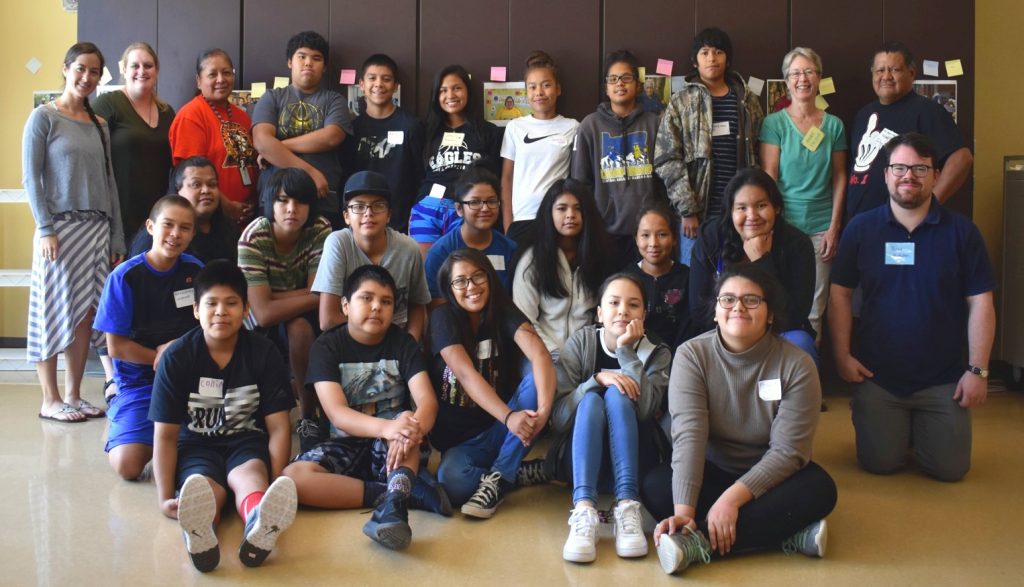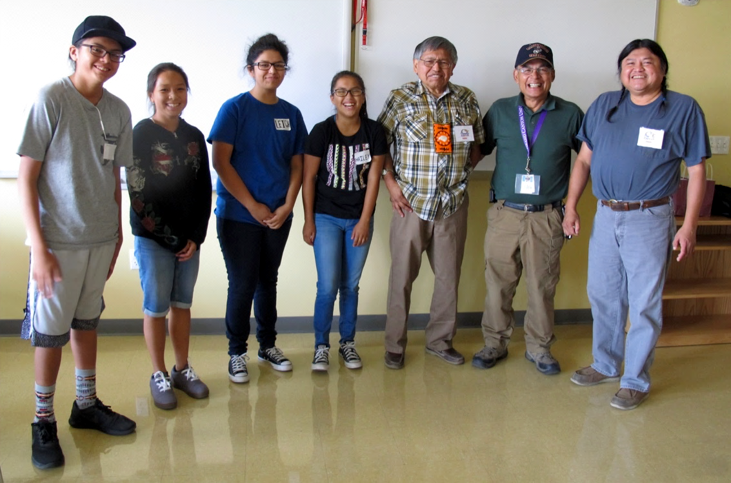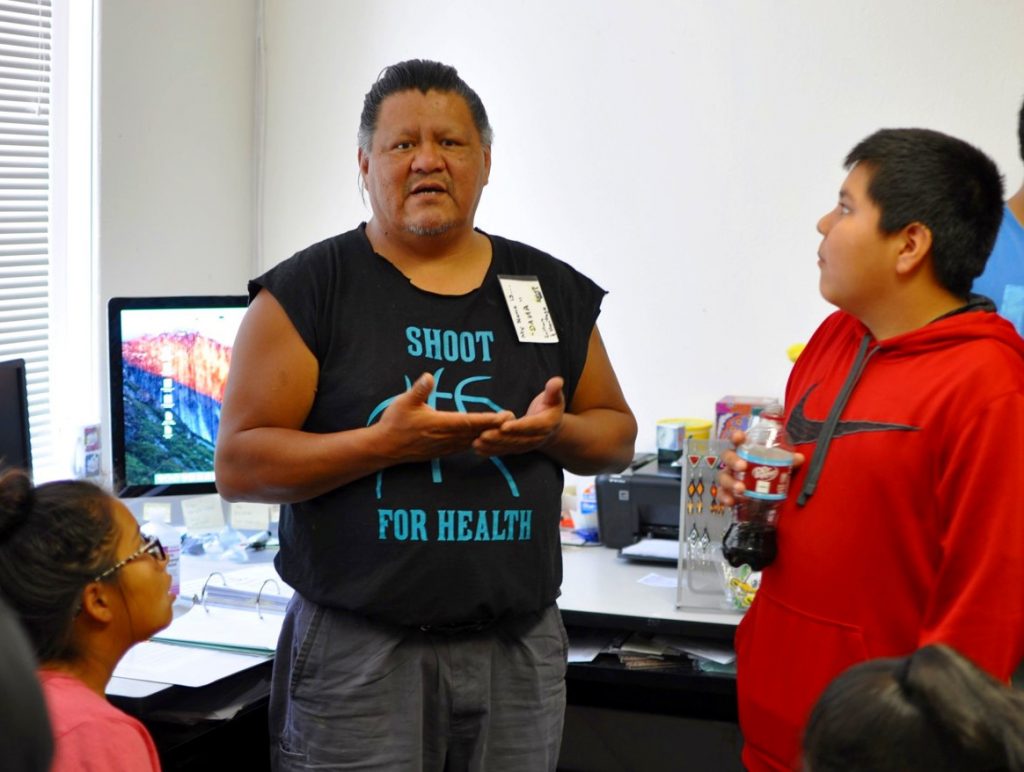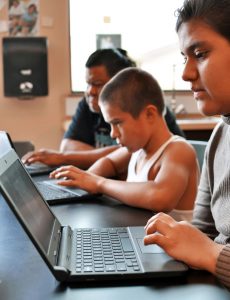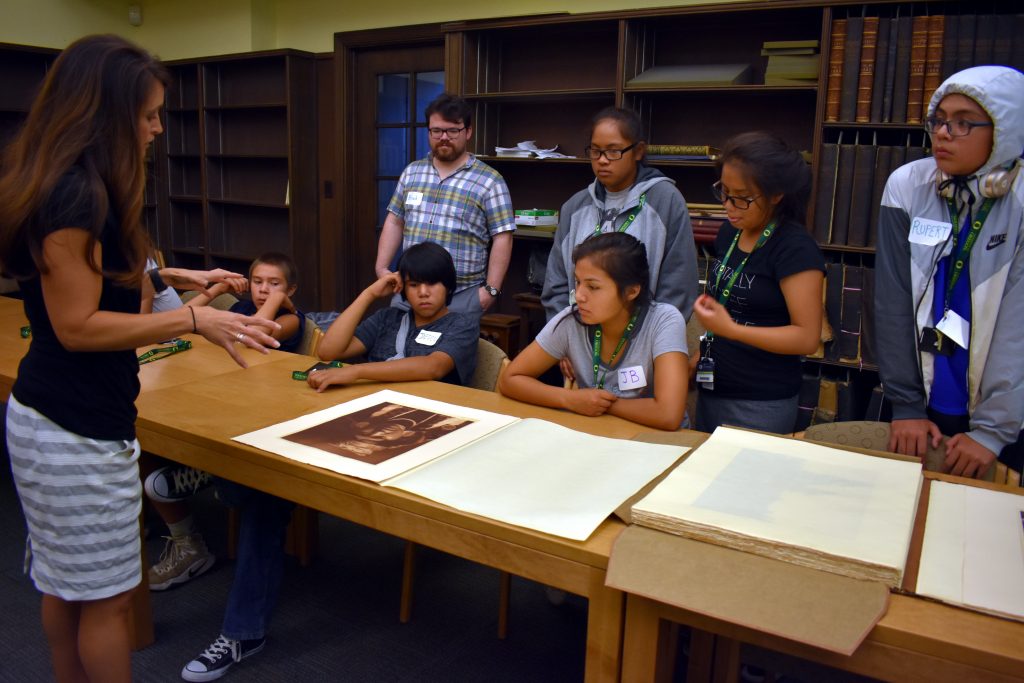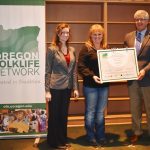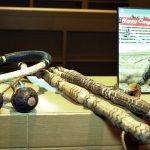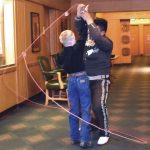Check out traditional Polynesian dancer Novelyn Tavita on the Oregon Culture Keepers Roster.
Media Corner – Jayanthi Raman
Watch TAAP Master Artist Jayanthi Raman (2015) and her apprentice Bakul Godbole demonstrate Bharatha Natyam Indian Dance.
Traditional artist Esther Stutzman receives 2017 Governor’s Art Award
Alina Mansfield

(left to right), Oregon Arts Commission Chair, Christopher Acebo; Esther Stutzman; Governor Kate Brown (photo, courtesy of the Oregon Arts Commission, ©2017)
OFN is pleased to announce that Traditional Arts Apprenticeship Program (2013) master artist Esther Stutzman received a prestigious 2017 Lifetime Achievement Governor’s Art Award for her work in Oregon as a traditional Kalapuya/Coos storyteller. OFN nominated her for the 2017 Governor’s Art Awards, Oregon’s highest honor for exemplary service to the arts, which Gov. Brown revitalized after a 10-year hiatus. Ms. Stutzman was recognized during a ceremony that preceded the 2017 Oregon Arts Summit on Oct. 6, in Portland.
In addition to being a 2012 Oregon Folklife Network TAAP awardee, Esther Stutzman (Kalapuya/Coos) is the primary storyteller for Mother Earth’s Children, an American Indian theatre group that has performed for school assemblies and a variety of events and conferences for the past 42 years. Stutzman also works with Title VII Indian Education programs and Arts in Education Programs throughout the state of Oregon as a cultural resource specialist with children as well as with teacher in-service programs. She has been a long-time presenter for the Oregon Chautauqua History Series and is a recipient of several folklife awards formerly administered by the Oregon Historical Society. She recently shared her Tribes’ Mother Wolf and Coyote stories at the Museum of Natural and Cultural History in Eugene for their Wolf Talks celebration.
2017 Warm Springs Folklife Field School Highlights
Jennie Flinspach and Brad McMullen
The 2017 Warm Springs Folklife Field School engaged rising eighth graders from the Confederated Tribes of Warm Springs K-8 Academy in a week-long adventure to explore their heritage and document their cultural traditions.
Students learned fieldwork skills by interviewing each other. Using OFN’s recording equipment, students questioned each other about treasured family objects.
Students worked in groups to conduct interviews with tribal elders. We were honored to hear the elders’ share moving accounts of their heritage and traditions.
On Wednesday, students and staff took a field trip to the Warm Springs Culture and Heritage Department. Tribal archivist, Creston (Dana) Smith, one of our on-site teachers, showed us how he preserves the recorded history and culture of Confederated Tribes of Warm Springs.
After their interviews, students learned to process and analyze audio clips from their audio recordings. They wrote reflections, recorded narration, and assembled clips into a group presentation.
One of the special highlights of the week was Thursday’s visit to the Warm Springs radio station, KWSO 91.9 FM, where Marge Kalama, local radio personality, conducted a live on-air interview with the students.
At the end of the week, the students presented their research to the Warm Springs community. It was the perfect way to end a great week of cultural documentation! But there was still more in store for these young folklorists…
Two weeks later, the students traveled to the University of Oregon for an overnight campus visit. They visited Special Collections, where Corrigan Solari University Historian and Archivist Jennifer O’Neal showed them the Edward Curtis photographic collection, an invaluable collection of late 19th-century Native American portraits and images of traditional occupations and lifeways.
At the Jordan Schnitzer Museum of Art, Curator Cheryl Hartup gave a tour of “Conversations in the Round House: Roots, Roads, and Remembrances,” an exhibit of native works including one from Warm Springs elder, Lillian Pitt.
A stop at the Museum of Natural and Cultural History included a tour of the new Cultural Wing, which includes exhibits and short documentaries about Oregon’s native Tribes, past and present.
Our guests enjoyed a backstage tour of Matthew Knight Arena, where they got to “throw their O” at center court. Capping off the afternoon was a walk through Kalapuya Ilihi Hall, the newest residence hall on campus and home to the new Native American and Indigenous Studies academic residential community.
The next morning, Warm Springs students presented their research at the Many Nations Longhouse to UO Native students, faculty, and staff. At a special luncheon that followed, audience members reciprocated and shared with students the many opportunities and resources available to them as future UO Ducks.
Before heading back to Warm Springs, students had some fun with Professor Kirby Brown (English Department, Native literature), who taught them how to play sjima. Sjima, also known as Shinny Ball, is a traditional game with similarities to hockey and lacrosse and is specific to Oregon’s Klamath tribes.
TAAP Master Artists Recognized at Legislative Event
On Monday November 13th, state officials recognized Oregon’s 2016-2018 Traditional Arts Apprenticeship Program master artists at the State Library in Salem, Oregon.
The ceremony opened with words of welcome from MaryKay Dahlgreen (State Librarian), Riki Saltzman (Executive Director, Oregon Folklife Network), Brian Rogers (Executive Director, Oregon Arts Commission and Oregon Cultural Trust), and Beth Dehn, newly appointed Manager, Oregon Heritage Commission. Brian Rogers and state legislators, Representative Margaret Doherty (District 35), Representative Cliff Bentz (District 60), Representative Andrea Salinas (District 38), and Greg Mintz, Legislative Director for Senator Ken Helm (District 34), presented commemorative certificates to master artists (pictured R-L) Tonya Rosebrook, Hossein Salehi, Azar Salehi, Marjan Anvari, Jack Armstrong, Sara Siestreem, Anita Menon, and Feryal Abbasi-Ghnaim. Apprentice Miguel Ruiz and his son Miguel Jr. accepted the award on behalf of his mentor, Antonio Huerta. Representative Cliff Bentz and Brian Rogers presented a certificate to Roberta Kirk in absentia. The ceremony, which recognized the artistic excellence of these exemplary culture keepers, featured virtuosic performances by Azar Salehi (Persian storytelling) and Hossein Salehi (Persian santoor, a trapezoidal-shaped stringed instrument similar to the hammered dulcimer).
During a reception in their honor, TAAP master artists had the opportunity to interact with each other as well as elected officials, state government representatives, OFN staff, and members of the Oregon Arts Commission and Cultural Trust boards. Many brought examples of their works to share, demonstrate, and display their artistry. Charrería apprentice, Miguel Ruiz, treated everyone to an impromptu display of the roping skills required for Mexican rodeo.
Congratulations again to all of the 2016-18 TAAP master artists. We also extend our appreciation to all who were able to attend and honor those artists and their contributions to Oregon’s living cultural heritage.
- Riki Saltzman, Anita Menon, and Brian Rogers
- Riki Saltzman, Miguel Ruiz, Miguel Ruiz Jr. and Representative Margaret Doherty
- Emily West Hartlerode, Azar Salehi, and Brian Rogers
- Beth Dehn, newly appointed Manager, Oregon Heritage Commission
- OFN Program Coordinator Alina Mansfield and Graduate Student Assistant Brad McMullen
- Brian Rogers (Executive Director, Oregon Arts Commission and Oregon Cultural Trust)
- Hossein Salehi playing Persian santoor, a trapezoidal-shaped stringed instrument similar to the hammered dulcimer
- Hossein Salehi playing Persian santoor
- Riki Saltzman, Jack Armstrong, and Representative Margaret Doherty, District 35
- Emily West Hartlerode, Marjan Anvari, and Representative Andrea Salinas, District 38
- Emily West Hartlerode, Representative Cliff Bentz, District 60, and Brian Rogers present award to Roberta Kirk in absentia
- Riki Saltzman, Sara Siestreem, and Representative Margaret Doherty, District 35
- Emily West Hartlerode, Toyna Rosebrook, and Representative Cliff Bentz, District 10
- Emily West Hartlerode, Hossein Salehi, and Brian Rogers
- Riki Saltzman, Feryal Abbasi-Ghnaim and Representative Margaret Doherty, District 35
- Examples of artists’ work
- Examples of Jack Armstrong’s braided rawhide bosals and quirts.
- Examples of Feryal Abbasi-Ghnaim’s fine embroidery on miniature Palestinian dresses.
- At the reception
- Miguel Ruiz Jr. and his father, Miguel Ruiz
- Representative Margaret Doherty (District 35) and Jack Armstrong
- Representative Cliff Bentz (District 60) and Jack Armstrong
- Representative Cliff Bentz (District 60) and Tonya Rosebrook
- Representative Andrea Salinas (District 38) and Marjan Anvari
- Miguel Ruiz Jr. demonstrating charrería (roping) skills.
- Miguel Ruiz demonstrating charrería (roping) skills.
- Miguel Ruiz Jr. demonstrating charrería (roping) skills.
TAAP Artist Profile: Feryal Abbasi-Ghnaim

Feryal Abbasi-Ghnaim is master Palestinian embroiderer. Born in the city of Safad in northern Palestine, her family fled to Syria and Jordan in 1948. After attending boarding school in Ramalla West Bank, Abbasi-Ghnaim returned to Syria to attend Damascus University, where she majored in art history. In 1980, her family immigrated to the United States. Abbasi-Ghnaim has dedicated herself to practicing and teaching her traditional craft. She has lectured and taught about Palestinian traditions at the University of Massachusetts, the Oral History Center of Cambridge, Portland State University, and Lewis and Clark College. She has collaborated with the World Affairs Council of Oregon and the Middle East Studies Center to participate in the “Teach the Middle East” forum, a set of workshop designed to train youth and K-12 educators about Middle East culture and arts. Since 2000, Abbasi-Ghnaim has taught workshops and classes in public schools in Beaverton, Milwaukie, Gresham, and Portland.
Palestinian embroidery features minute cross-stitching, most easily compared to counted cross-stitch. But the craft involves much more than a decorative art; stitches and design combine to tell stories with colors, symbols, and patterns. Abbasi-Ghnaim continues a centuries-old tradition that Palestinian women have employed to record their cultural observations. As Abbasi-Ghnaim explains, “Embroidery is the unwritten language transferring stories from woman to woman in silence. Needle and thread are the tools for documenting the history of their lives … The stories behind the patterns, the colors of the thread, and the fashion of traditional Palestinian dress are just as important as learning the cross-stitch and is something that can only be preserved through teaching and mentoring the younger generations.”
Abbasi-Ghnaim earned Traditional Arts Apprenticeship Program awards with Oregon Folklife Network in 2012, 2014, and 2018 and worked extensively with the OFN’s predecessor folk and traditional arts programs in prior years.
To learn more about Feryal, check out her daughter’s book, Tatreez and Tea: https://tatreezandtea.com/
TAAP Artist Profile: Obo Addy
Obo Addy (January 15, 1936-September 13, 2012), Ghanaian Drumming, Portland (Multnomah), 2012
Obo Addy was a dynamic musician, generous teacher, and gifted composer. The son of a Ga wonche (medicine man), Addy was designated a master drummer at the age of six in Accra, Ghana. His life’s work was to share his culture through music, dance, and drum.
During childhood, he recalled, “I was constantly surrounded by … drumming, dancing, and singing …. My siblings and I listened, observed, and helped as needed when my father performed various spiritual ceremonies and rites. From these proceedings I learned about the power of music, drumming, and rhythms. In rituals, I first learned to play bell. Later, I was allowed to play drums. In between these events and lessons with my father, I played on my own and with other musicians at social gatherings in town. As a small boy, I knew that I wanted to be musician.”
In 1969, the Arts Council of Ghana employed Addy as a Ga master of the national music. He and his brothers performed at the 1972 Olympic Games in Munich and toured internationally until Addy moved to Portland, Oregon. Addy was one of the first native African musicians to bring worldbeat (a fusion of traditional folk music and Western pop music) to the west. In 1978, he and his wife, Susan Addy, created Homowo African Arts and Cultures to promote Ghanaian music. Addy, who taught at Lewis and Clark College, created programs and curriculum to demonstrate the connections between African and African American music and dance, which he taught and performed around the United States.
In 1996, the National Endowment for the Arts awarded Obo Addy a National Heritage Fellowship, the highest honor a traditional artist can receive in the United States. His numerous recordings include Wonche Bi (2002) and Afieye Okropong (2003), released on the Alula label. In 2011, Homowo became the Obo Addy Legacy Project to further honor his contributions.
To learn more about the Obo Addy Legacy Project, check out their website: http://oboaddylegacyproject.org/
Two contract folklore positions! RFP: Due Nov 15, 2017
More Than $82 Million Awarded for Arts Projects Nationwide – Includes $80,000 awarded to the Oregon Folklife Network
[Eugene]—National Endowment for the Arts Chairman Jane Chu has approved more than $82 million to fund local arts projects across the country in the NEA’s second major funding announcement for fiscal year 2017. Included in this announcement is an Art Works award of $80,000 to the Oregon Folklife Network to support Oregon’s folk and traditional arts programming and research. The NEA received 1,728 Art Works applications and will make 1,029 grants ranging from $10,000 to $100,000.
“The arts reflect the vision, energy, and talent of America’s artists and arts organizations,” said NEA Chairman Jane Chu. “The National Endowment for the Arts is proud to support organizations such as the Oregon Folklife Network in serving their communities by providing excellent and accessible arts experiences.”
“We are thrilled to have the NEA’s funding and endorsement of our efforts to engage with communities, organizations, and Tribes to document, preserve, and celebrate Oregon’s living cultural heritage,” commented Riki Saltzman, OFN’s executive director. “We are also pleased to have additional funding from the Oregon Arts Commission for this important cultural work.”
NEA and OAC funding supports OFN’s Traditional Arts Apprenticeship Program, our statewide multi-year folklife survey, and our Regional Collaborative Partnerships. Since 2012, OFN has supported over 30 Traditional Arts Apprenticeship teams to teach and make public presentations. Master artists mentor apprentices from the same cultural community or Tribe in a chosen traditional art form such as rawhide braiding, Coos basket weaving, and Persian storytelling.
Our next and 5th region of our statewide folklife survey will be the Willamette Valley; during 2018 we’ll be out and about to interview river guides, musicians, storytellers, quilters, and more. Previous surveys have identified and documented hundreds of traditional artists in communities and Tribes in southern and eastern Oregon, the Gorge, and the Portland Metro.
Following each region’s folklife survey, OFN staff provides support to create or supplement projects that focus on and documented artists from that region. For 2017-18, we’ll be partnering with cultural organizations and Tribes in eastern Oregon for our next round of Regional Collaborative Partnerships.
Check out our ever-growing Culture Keepers Roster to discover and hire Oregon folk artists. Many of those culture keepers have performed in Oregon parks, taken part in festivals, conducted public workshops, and been featured in exhibits.
To join the Twitter conversation about this announcement, please use #NEASpring17, #Oregonfolk, and #thisisculture. For more information on projects included in the NEA grant announcement, go to arts.gov.
Follow OFN on Twitter @OregonFolklife and follow us on Facebook at Oregon Folklife Network.
Apply Now! Native American and Culture Foundation Mentor Artist Fellowships
 The call is now open to established American Indian and Alaska Native artists to apply for a one-year NACF Mentor Artist Fellowship to mentor an emerging American Indian and Alaska Native artist apprentice. Established artists should have at least ten years of experience in the Traditional Arts or Contemporary Visual Arts fields.
The call is now open to established American Indian and Alaska Native artists to apply for a one-year NACF Mentor Artist Fellowship to mentor an emerging American Indian and Alaska Native artist apprentice. Established artists should have at least ten years of experience in the Traditional Arts or Contemporary Visual Arts fields.
Applications will be accepted until 5 p.m. Pacific Time, on Monday, November 6, 2017.
Awarded Mentors will develop lesson plans intended to increase their apprentice’s skill level, and provide an experience of intergenerational exchange of cultural knowledge within the apprentice’s traditional arts or contemporary visual arts practice. To assist in developing lesson plans, awarded mentors and their apprentices are required to attend a training session before the mentorship begins. The training date will be announced upon notification of the awards.
This is a regional fellowship focusing in the Pacific Northwest, Southwest and Upper Midwest areas of the United States. Eligible applicants must be at least a five-year resident of, and enrolled in an American Indian tribe or Alaska Native corporation located in Alaska, Arizona, Minnesota, New Mexico, North Dakota, Oregon, South Dakota, Southern California (Imperial, Kern, Los Angeles, Orange, Riverside, San Bernardino, San Diego, San Luis Obispo, Santa Barbara and Ventura counties), Washington or Wisconsin. Submission of documentation of American Indian and Alaska Native heritage is part of the application process.
First year Mentor Artist Fellow Lani Hotch (Chilkat Indian Village) said of receiving her award, “I’ve tried to work with groups of weavers, and I’m excited to work one on one with somebody so they know all the steps. In the last few months we’ve lost two weavers (…). I’m feeling a real compulsion to teach somebody.” Mentor Artist FellowShirod Younker (Coquille, Coos) said in response to the mentor training, “[A] good way to build focus [on] what we are doing and think about the macro vision of the projects in conjunction with each other.”
The Mentor Artist Fellowship is a monetary award of $30,000 — $20,000 to the mentor, $5,000 for the joint art project and $5,000 for the apprentice’s expenses — gas, supplies. Applications will undergo a selection process and fellowship awardees will be announced in the Spring of 2018. The mentoring period will be from July 1, 2018 through June 30, 2019. To demonstrate the experience and success of the mentoring, a completed joint mentor/apprentice art project is required at the Fellowship’s end.
For more information and to apply click here.
To learn more about previous NACF Mentor Artist Fellows, visit our website at http://www.
The Mentor Artist Fellowship Program is generously supported by individual donors and regional funders committed to preserving and perpetuating Native arts and cultures. NACF is grateful to the James F. and Marion L. Miller Foundation for supporting an Oregon Mentor Fellow.

